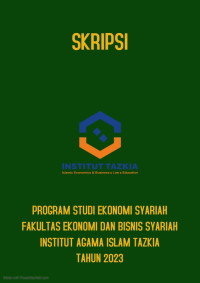Electronic Resource
Efficiency Analysis Of Sharia Regional Development Banks Using The Two-Stage Data Envelopment Analysis Method
Objectives: This study aims to analyze the efficiency level of Islamic Regional
Development Banks and determine the factors that can affect the efficiency level
of Sharia BPDs using the Two-Stage Data Envelopment Analysis method in the
2017-2021 period. The sample in this study were 3 Sharia BPDs in Indonesia
which were registered with Bank Indonesia.
Methods: The method of analysis in this study in the first stage (first stage)
measures the level of efficiency of Islamic BPD with the DEA intermediation
approach. The second stage (second stage) analyzes the determinants that affect
the level of efficiency of Islamic BPD by using tobit regression analysis.
Results/Findings : The results of this study indicate that there are 2 sharia BPDs
that have achieved an efficiency level of 100%, namely Bank NTB Syariah in
2018, 2019 and 2021. And UUS BPD Bank Riau Kepri Syariah in 2018 and 2021.
Meanwhile, Bank Aceh Syariah has not achieved 100% efficiency . namely in
2017 -2021. Likewise Bank NTB Syariah in 2017 and 2020, while UUS Bank
Riau Kekpri Syariah in 2017, 2019 and 2020. The results of the tobit regression
analysis show that the ratio of FDR and NPF has a real influence in achieving the
efficiency level of Islamic BPD. Then, the POJK regulations concerning Banking
Synergy have a positive and insignificant effect on the efficiency level of sharia
BPD. Meanwhile, the ROA and Inflation variables have no effect and do not
make a real contribution to achieving efficiency in sharia BPD.
Availability
Detail Information
- Series Title
-
-
- Call Number
-
REF 332.1 YUR e
- Publisher
- Bogor : IAI Tazkia., 2023
- Collation
-
ES
- Language
-
English
- ISBN/ISSN
-
NIM.19103033
- Classification
-
332.1
- Content Type
-
-
- Media Type
-
-
- Carrier Type
-
-
- Edition
-
-
- Subject(s)
- Specific Detail Info
-
-
- Statement of Responsibility
-
Aditya Yuriangga
Other version/related
No other version available
File Attachment
Comments
You must be logged in to post a comment

 Computer Science, Information & General Works
Computer Science, Information & General Works  Philosophy & Psychology
Philosophy & Psychology  Religion
Religion  Social Sciences
Social Sciences  Language
Language  Pure Science
Pure Science  Applied Sciences
Applied Sciences  Art & Recreation
Art & Recreation  Literature
Literature  History & Geography
History & Geography